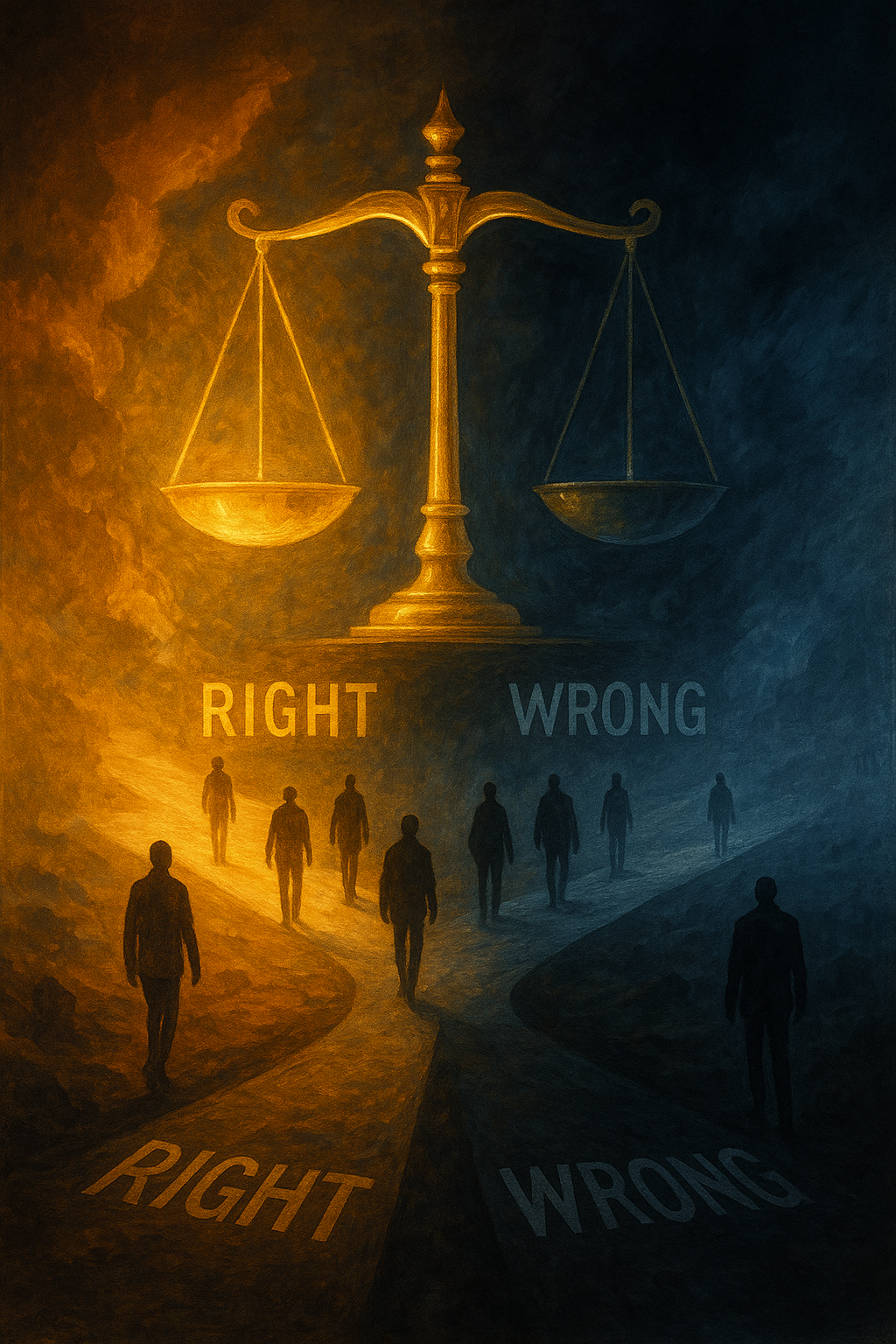
Part 1: Framework. Principles as a Response to Chaos
From time to time, life poses questions that have no ready answers in textbooks. Conflicting interests, the need to make difficult choices, pressure from circumstances. Over time, I realized that one can only rely on an inner core—a system of principles honed by experience. This is not dogma but an intellectual tool. It allows you not to reinvent the wheel in a crisis but to act clearly, maintaining face and dignity.
First Principle: Nonviolence is a strategy, not a weakness.
Force applied without extreme necessity is a sign not of confidence but of a weak mind. It destroys more than it creates. True strength lies in the ability to exhaust all other means—dialogue, agreements, social mechanisms—before resorting to brute force. And certainly never to use it first. This rule applies not only to physical confrontation but to any pressure: emotional, financial, administrative. The goal is not to break the will but to find a solution that stops the damage with minimal losses for all parties. This requires much more endurance and strategic thinking.
Second Principle: Truth as the foundation of trust.
Trust is the most solid currency in the long run. Its rate cannot be faked. A lie, even the smallest one, triggers a chain reaction of instability. It requires constant support with new lies, undermining reputation and clarity of thought. Therefore, the rule is simple: tell the truth. Always. Even when it is unprofitable.
There is only one exception that proves the rule: concealing the truth is permissible exclusively to save a human life or prevent irreparable harm. Not for convenience, not to avoid conflict, not to save reputation. Only to save a life. This is a heavy moral choice, the responsibility for which you fully bear.
Third Principle: Hierarchy of values. Life is above all.
Everything else—agreements, ideologies, property disputes—is secondary. Any conflict should be assessed through this prism. A threat to life or health is a red line, crossing which immediately shifts the situation to another category and justifies the use of any means to protect it. Everything else can be resolved.

Part 2: Social Contract. From Personal Ethics to Public
Developed principles are useless if they remain only an internal conviction. They must work in society, in the family, in business. It is there that their viability is tested.
Fourth Principle: Justice and mercy—in the right sequence.
Justice is the foundation of order. It requires that action be followed by an adequate reaction, that violations be stopped, and rules be observed. Without this, any system collapses. Mercy, forgiveness—is the next step. After justice has triumphed, damage is compensated, and protective mechanisms are launched, one can talk about leniency. Mercy instead of justice is not kindness; it is indulgence that encourages further violations. First—inevitability of consequences, then—the possibility of redemption.
Fifth Principle: Subsidiarity. Solve problems at your level.
A highly harmful habit is to shift responsibility to higher authorities: management, the state, "the bosses." This breeds helplessness and dependency. The healthy principle is: a problem should be solved at the level at which it arose, by those whom it directly affects. This develops competence, initiative, and strengthens horizontal ties. Turning to "the top" is justified only when all possibilities at the local level are exhausted. The center is not a source of solutions but a reserve mechanism.
Sixth Principle: Amanat. Responsibility for what is entrusted.
Power, money, access to information, leadership of people—this is not a personal privilege. This is amanat—entrusted for safekeeping. It should be managed not as an owner but as a trustee: with frugality and transparency, and with the obligation to report. Abuse of entrusted resources is not just a mistake; it is a fundamental betrayal that undermines the very possibility of trust in society.

Part 3: Intellectual Hygiene and the Future
The modern world has added new challenges to the classic ones: information noise, technology, the speed of change. Principles are indispensable here as well.
Seventh Principle: Epistemic humility.
Simply put—acknowledging the limits of one's own knowledge. Confidence in one's rightness is the main source of mistakes. Therefore, the critically important rule is: before challenging someone else's position, be able to honestly and accurately formulate it so that your opponent agrees with your presentation. This is an iron disciplining technique that cuts off fighting with imaginary arguments and forces you to delve into the essence. Doubt should lead to verification, not dogmatism.
Eighth Principle: Ethical antivirus.
The information environment is toxic. Therefore, a personal protocol is necessary: do not spread unverified data. The algorithm is simple: pause → check with two independent sources → if in doubt, mark as "unverified" → if you made a mistake, publicly correct yourself → draw conclusions. This is a matter of mental hygiene and social responsibility.
Ninth Principle: Technology is a tool, not a judge.
AI, algorithms, Big Data—cannot bear ethical responsibility. Critically important decisions, especially those affecting people's destinies (loans, sentences, hiring) should remain with a person who has a conscience and is capable of mercy. A ban on systems built on exploitation or causing harm is the "base."

I think it's hard to understand the logic of this morality without examples. Let me give examples from everyday life to give you an understanding.
SITUATION 1: Business conflict (Partner violates agreements)
Usual reaction: Immediately threaten with court, air dirty laundry, pressure with pity or, conversely, aggression. Result: permanently ruined relationships, time and money lost on lawyers, reputation as a scandalist.
Action by principles (cold calculation):
R-MAP (Assessment):
Risk: High. Financial losses, project disruption.
Means: Have soft options been exhausted? Yes. Negotiations were held. Move to tough but legitimate ones.
Goal: Not to punish the partner, but to protect your business and minimize losses.
Proportionality: Measure—official complaint and resolution through arbitration, not personal blackmail or threats.
D/P/D Algorithm (Decision Making):
Duty: I have a contract and the right to defend it.
Consequences: Court is expensive and long. Can an exit be proposed? For example, exit the project with compensation? This will save some money and time.
Virtue: Act like a professional: firmly, but without gloating.
Outcome: You send the partner an official but polite complaint with a clear calculation of losses and an offer of two paths: 1) Out-of-court settlement on your terms. 2) Arbitration. You do not get personal; your position is based on facts. You protect your interests without descending into scandal. This preserves your face and gives better financial chances.
SITUATION 2: Quarrel with a close person
Usual reaction: Prove your rightness, resort to insults, recall old grievances. Or silence the problem, harboring resentment.
Action by principles (conscious dialogue):
Nonviolent communication:
Observation (without evaluation): "When you didn't call back today, even though we agreed..." (instead of "you forgot about me again!").
Feeling: "...I felt anxious and frustrated."
Need: "...because reliability and respect for mutual agreements are important to me."
Request: "Can you just text next time if you can't make it?"
Clarification before the argument: Before expressing your complaint, you say: "Do I understand correctly that you didn't call back because there was an urgent emergency at work?" You give the person a chance to explain and show that you are trying to understand them, not just attack.
Outcome: You do not suppress your feelings but express them constructively. You attack the problem, not the person. This does not guarantee that the conflict will disappear, but it shifts to the plane of dialogue, not war. This requires self-control but saves relationships.
SITUATION 3: You are provoked into conflict (Accident, queue, rudeness online)
Usual reaction: Give in to emotion, get into a fight (physical or verbal), ruin your day.
Action by principles (strength in restraint):
Escalation ladder: You automatically check which step you are on.
Word: Can this be resolved with a word? Apologize, even if not at fault, to de-escalate the situation? ("Sorry, I didn't notice").
Social pressure/boycott: If rudeness online—just ban the provocateur without engaging in discussion. Deprive them of the audience.
Law: If an accident—call the police, act according to instructions. Do not take the law into your own hands.
Physical protection: Only if there is a direct threat to life and health. In all other cases, it is a loss.
The goal is to stop harm, not to win. Your goal is not to prove to the jerk that he is a jerk but to save your time, nerves, and health. The strongest move is to refuse to play by his rules.
Outcome: You exit the situation without losses, and the provocateur is left with nothing. You save your resources for something important.
SITUATION 4: You witness injustice (Bullying, rights violation)
Usual reaction: Walk by ("not my business"), or rush to help rashly, worsening the situation.
Action by principles (measured intervention):
Priority of protecting the weak. This is unconditional. But how?
Assess the risk with R-MAP: Will your direct intervention worsen it? Maybe it's safer to call someone with more authority (security, manager)? Or record the violation on video and then pass it to human rights defenders?
TIC-4 (Trauma-Informed Approach) when communicating with the victim:
Safety: "Are you safe now?"
Choice: "Do you need help? Maybe call someone?" (do not impose your solution).
Collaboration: "Can I help you with something?"
Amplifying voice: "Would you like me to help you write a statement or stay with you?"
Outcome: You do not pass by, but your help is not heroism with fists, but a thoughtful, effective action that can really help, not harm.
SITUATION 5: Personal efficiency and burnout
Scenario: Work emergency. You feel tired, irritated, but continue to push yourself because "you have to."
Usual reaction: Work nights, on caffeine and stress. Snap at loved ones. Complete the project but get a neurosis and ruin your health.
Action by principles:
You remember that your health and psyche are also amanat, entrusted to you. They cannot be squandered.
Principle of "Sabbath 24 hours": You consciously allocate one day a week (not necessarily Sunday) that is completely free from work. No checking emails, calls, thoughts about the project. This is not laziness—this is maintenance of your main tool.
Principle of "Goals—only protection": You ask yourself: "Am I acting from a position of strength and creation or from fear and the need to prove something?". If the latter—it is a warning bell.
Action: You inform the team/manager: "Colleagues, I am disconnecting for 24 hours for recovery. For urgent matters, call the deputy." You go to sleep, read a book, walk in the forest—do what has no KPI and immediate result.
SITUATION 6: Raising a child (Misconduct and consequences)
Scenario: A teenager lied about where they were in the evening, and you found out.
Usual reaction: Yelling, scandal, total restriction of all freedoms ("now you're grounded for a month!"). Result: fear, resentment, loss of trust, sophisticated attempts to lie better.
Action by principles (Justice + Mercy + Restoration):

Leave a comment
Comment